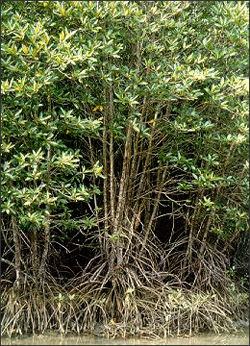
Giri and other researchers used more than 750 Landsat satellite images to identify the remaining mangrove forests of the region, to quantify the rates and causes of change from 1975 to 2005, and to identify deforestation ‘hot spots,’. Landsat is the world’s longest continuously acquired collection of space-based land remote sensing data. The study found that the major factors responsible for mangrove deforestation in the study area include agriculture encroachment (81%), aquaculture (12%), and urban development (2%). However, shrimp farming is on the rise in Indonesia and Thailand.
Time-series analysis of historical data from the Landsat archive also suggests that the tsunami-impacted region lost 12% of the mangrove forests from 1975 to 2005, much lower than estimated mangrove loss in Asia, which ranges from 25 to 50%. According to Giri and the other researchers, mangrove loss varies according to country and time period. Their study found that the annual rate of deforestation was highest in Burma (~1%) and lowest in Sri Lanka (0.1%) from 1975 to 2005. In contrast, mangrove forests in India and Bangladesh remained unchanged or gained a small percentage during the period. Similarly, net deforestation peaked at 137,000 ha during 1990-2000, increasing from 97,000 ha during 1975-1990 and declining to 14,000 ha during 2000-2005.
Data and information generated from this study can be used to identify potential rehabilitation sites, set conservation priorities, and quantify the role of mangrove forests in saving lives and property from natural disasters such as the Asian tsunami.
Contributor: Davina Quarterman, Blackwell Publishing Ltd.
Further Information:
+ C. Giri, Z. Zhu, L. L. Tieszen, A. Singh, S. Gillette, J. A. Kelmelis (2007). Mangrove forest distributions and dynamics (1975-2005) of the tsunami-affected region of Asia. Journal of Biogeography (OnlineEarly Articles). doi:10.1111/j.1365-2699.2007.01806.x

Be Part of What’s Next: Emerging Applications of Landsat at AGU24
Anyone making innovative use of Landsat data to meet societal needs today and during coming decades is encouraged to submit and abstract for the upcoming “Emerging Science Applications of Landsat” session at AGU24.





